Beyond the known world is a galaxy of infinite exploration and endless possibility. That is, of course, until you meet your end at the whim of an angry detachment of Sentinels, or breathe in too many atmospheric toxins and collapse on the surface of some backwater planet. With over “18 quintillion” procedurally-generated planets to explore, there’s heaps to see (and flee in terror from) in No Man’s Sky VR. While No Man’s Sky developer Hello Games has called the new BEYOND update the ‘2.0’ version of the game, No Man’s Sky’s brand new VR support feels like ‘1.0’ in many key respects, jarringly reminding me that while the sky’s the limit for the studio, their flagship title’s initial entry into virtual reality has some serious turbulence to work through.
No Man’s Sky Beyond/VR Details:
Developer: Hello Games
Available On: Steam (Vive, Index, Rift), PlayStation Store (PSVR)
Reviewed On: Rift (CV1)
Release Date: August 14, 2019
Price: $60
Note: While No Man’s Sky Beyond is the title’s seventh major update in over three years, we’re focusing solely on how the VR portion of the update plays in its current state. Understanding that save progress and multiplayer gameplay are seamlessly shared with the game’s flatscreen mode and flatscreen players, this review does not reflect the experience that a player may have if/when they choose to play No Man’s Sky Beyond outside of a headset.
Gameplay
The only laws in a procedurally-generated universe are the ones you choose to follow. No Man’s Sky VR begins its descent into lawlessness by letting you choose between loading up an existing save or starting an entirely new one. You’re given four save slots, corresponding with the four modes available to choose from as a new player: ‘Normal’, ‘Survival’, ‘Permadeath’, and ‘Creative. If your PSN or Steam friends are online, you can even jump directly into a session with them from the main menu.
While ‘Normal’ is ostensibly the most popular—at least, it constitutes the definitive No Man’s Sky VR experience—there’s an entirely different experience hidden in each mode. ‘Survival’, for instance, keeps most of the core gameplay intact but challenges you with modifiers that make every action less rewarding and every potential threat more dangerous. ‘Permadeath’, which is something I’d never want to experience in a game that can rack up tens, hundreds, or thousands of hours of play, is aimed squarely at those who crave a vastly heightened feeling of urgency in the game’s exploration and combat encounters. Meanwhile, ‘Creative’ is far more permissive towards those who just want to chill out and build bases, offering invulnerability and limitless crafting supplies.
Note: The remainder of this review is based on my time in the ‘Normal’ difficulty mode, which encompasses the baseline No Man’s Sky VR experience.
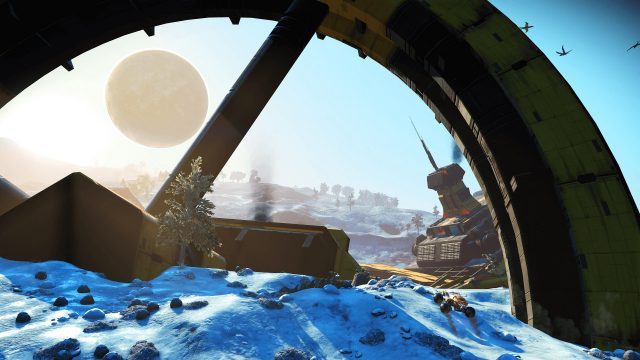
Opening a new save file from scratch one, the immediacy of survival becomes clear. You are no more than a tiny speck upon the surface of a dusty planet in an unfamiliar system. Finding yourself alone without a spaceship or a weapon, surrounded by hostile atmosphere and aggressive wildlife, you quickly realize that your protective exosuit is failing and that you are going to die in short order if you don’t do something about it.
But there is hope. On the lower right corner of your helmet display, a tutorial canvas informs that you’ll survive—if you repair your scanner and fetch up a source of sodium, the naturally-occurring element that allows you to recharge your suit’s ‘Hazard Protection Unit’. Following these directions, in addition to keeping you alive, begins a series of small tasks that you’re compelled (not required) to complete as you gain familiarity with your environment, your equipment, the interface, and very shortly, your first ship.
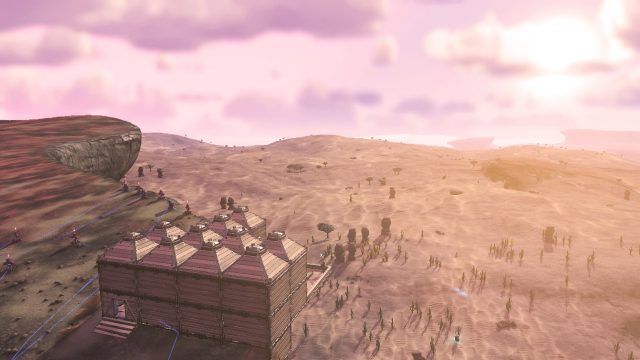
No Man’s Sky VR doesn’t intently hold your hand, but it does give you pellets to follow in the form of primary missions. For the first several hours, each of the game’s systems are taught on a task-by-task basis. Unfortunately, many of these first missions aren’t telling you much more than “go here, do this” without a stronger narrative context. And since the game is so open-ended, they constitute no more than a subtle nudge for a player who wants to get out into the universe and explore sooner rather than later.
It’s an awkward juxtaposition, because there definitely is a narrative, but you won’t even come in contact with it until after completing the tutorial period, several hours into the game. In fact, the real meat of No Man’s Sky VR—the journey to the galactic core which features freighters, higher-tier solar systems, the Artemis story path, exocrafts, advanced base blueprints, and the ‘Space Anomaly’ multiplayer hub—is hidden behind the hyperdrive, which is awarded at the end of these lightly enforced, very helpful, but seemingly monotonous tutorial quests. The game certainly does teach you everything you need to know, but only if you’re patient, attentive, and willing to learn at the pace dictated by Hello Games.

As soon as you gain access to the wider universe, however, the real fun begins. Holistically, No Man’s Sky VR is hard to encapsulate because it can be so many things for so many people. There are such a great deal of systems running simultaneously that it’s difficult to keep track of what to do and where to go at any given time.
Are you interested in trading goods and lining your pockets? Each solar system has its own economy which responds to supply and demand; you can learn the best trade routes and even crash entire economies for your own benefit. Would you rather live out your juiciest intergalactic geoarchaeological fantasies? The galaxy is brimming with unmapped planets to find and scan, alien ruins to defile, and valuable treasures to dig out with the Terrain Manipulator.
And if you’re thinking about becoming a pirate, you don’t have to wait another moment. You can hunt civilian ships and loot their precious cargo, then warp away into the next system as you escape the justice of responding Sentinel authority interceptors.
As you accumulate Nanites, the game’s secondary currency that operates as a stand-in for experience points, you can buy upgrades for your Multi-Tool that let you earn more currency each time you scan a new oddity. Or you can spend those same Nanites on exosuit upgrades that keep you protected from extreme weather patterns, allowing you to explore longer without seeking shelter. If vehicle customization or bigger, better weapons are more your style, you can invest in those as well.
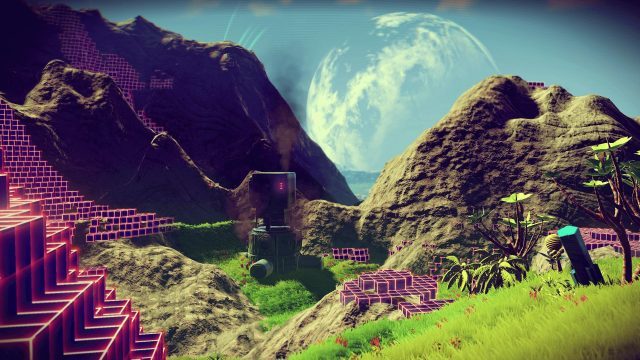
And those are only mere examples of what this game offers in terms of content and replayability. There’s also base-building, creature taming, undersea diving, exocraft racing, 32-person multiplayer, faction missions, bounty hunting, farming, crafting and smelting, artifact scavenging, black hole charting, frigate collecting, cave digging, punching mineral nodes to dust with your bare hands, and an entire 30 hours of story content. There’s even more to do than what I’ve listed, but the big question is how do any of these aspects feel while inside of a headset?
Immersion
I figure it’s worth examining what really ties this whole experience together: the spaceships. On the one hand, there’s a lot to be said about piloting a spaceship with a throttle and a joystick while staring out into space from the interior of your cockpit. That part is, for lack of a better term, extremely cool. And that first moment of blasting off from a planet’s surface and out into space may very possibly be memorialized as one of my favorite VR moments of all time.
As I broke atmosphere and launched into orbit, I took a moment to shut off the throttle and gaze into space. I drank in the panorama of planets casting shadows on one another, the flecks of cosmic dust hitting my ship’s exterior hull as it bumped around in the solar wind, the game’s idyllic retro-electronic synth pads harmonizing underneath it all. That was the moment that the gravitas of No Man’s Sky VR became clear to me. If I could see it in my headset, I could go to it. And nobody was going to stop me.
Other great moments followed shortly behind. My first dogfight in space was adrenaline-pulsing; slingshotting between asteroids to get the drop on an enemy ship while an ocean of stars swirled around in my peripheral vision. It was something out of a movie, though I could see how, even with consistent frame rates, dogfighting in VR may make other players sick.
My third favorite moment occurred after I’d dug a shelter out of a cave in the middle of an ice storm with the Terrain Manipulator, proudly stood in the middle of my room, watching the snowdrift blow into the cavern’s opening as light shone off the walls, in awe of what I’d created with my hands.
But No Man’s Sky’s greatest VR moments, for all they’re worth, are also why I ultimately am left so disappointed with much of how the rest of the game is presented. For every fantastic tidbit of VR immersion this title conjures up, there’s another poorly-translated relic from its flatscreen roots that mucks the entire experience. It pains me to say that the issues that have plagued No Man’s Sky since its launch: unintuitive interfaces, by-the-numbers NPC interactions, and immersion-breaking bugs—while far cleaner in the newest desktop version, they still crumble under the microscope of VR.
Too much of my time playing the VR update was spent drifting between large text boxes, busy menus, and digital cardboard NPC dialogues for me to truly absorb the grandiosity of the universe that Hello Games had laid out before me. Granted, while on foot, I still couldn’t shake the feeling that I was remotely controlling a player character—a human portal to a set of stats and records—rather than embodying that same character in a world that responded to me as a living being that actually existed. Which was, of course, to be expected from a port, but disappointing nonetheless.
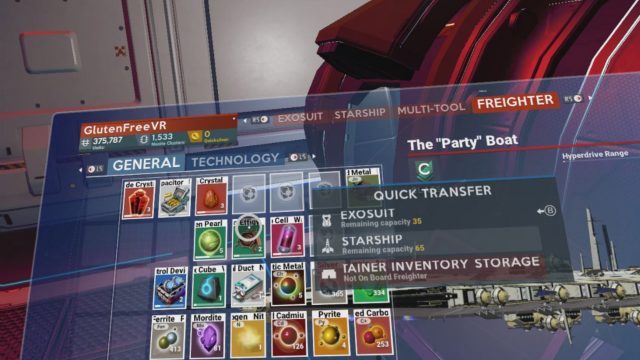
Scanning different lifeforms and minerals on each planet with the Analysis Visor and the Multi-Tool is one of the core elements of gameplay in No Man’s Sky VR, but even that piece involves standing in one place, pointing at something, and holding the trigger for a few seconds. It’s an overly rudimentary form of progression even in the desktop mode, and in stark contrast to the high-impact ship commandeering experience, it’s plain unfun in VR.
It doesn’t help that your Multi-Tool, the single thing you’ll invariably rely upon the most throughout your time in No Man’s Sky (aside from your ship), is hardly more than a floating mesh in VR. It offers no recoil or additional interactivity beyond a wrist-mounted menu, from which you can point and click on an icon to toggle between mining and weapon modules, or reload if you have a weapon module equipped. It’s just about the least immersive way to introduce a ‘gun’ mechanic in a VR game, and it explicitly casts the Multi-Tool as a weightless toy. This, in turn, makes many on-foot interactions feel disconnected—reminding you once more that you’re simply touring the world rather than existing inside of it.
The HUD is locked forward, meaning that it doesn’t follow your actual view around. Thus, I found that I needed to shift or even reset the HUD location using artificial locomotion each time I swiveled my head or turned my body while on foot. I understand that this is meant to accommodate for players who prefer to keep facing forward at all times, but the lack of an option to toggle off the HUD lock is a burden if, like me, you enjoy moving around your entire physical space.
Furthermore, it’s downright annoying when you forget that the HUD is entirely behind you but the game still thinks you’re facing in its static direction. This wouldn’t be as much of a problem if it didn’t have implications on gameplay, but it does. The ‘Rocket Boots’ module, an upgrade for the jetpack which is supposed to make navigating on foot much more convenient, automatically moves in the direction that your HUD is pointed. It’s activated by a quick tap of the same button that would otherwise activate the jetpack, which means that it’s easy to leap in the entirely wrong direction when you forget to reset your position or adjust to the direction of your HUD. It’s the sort of thing that jars you out of your experience if you aren’t paying attention, but even then, avoiding it altogether means remaining conscious of boring interface elements that are removed from the virtual world.

After receiving three years of new content, it’s easy to call No Man’s Sky a dense game, meaning that there’s a metric ton to do and see. Unfortunately, it’s still hard to call it a particularly deep game in any of its individual aspects. Many of its features still feel janky if not entirely thought through, despite seeing tangible improvement over the years. And it’s all the more visible in VR, where you’re literally standing inside of the world rather than watching an avatar stand in for you.
Alien encounters already felt nondescript and forgettable because each random encounter was still, ultimately, just a transaction attached to some random number generation. To this day, each random NPC interaction ultimately leads to another alien word learned or another item gained, all represented on canvas slate in the HUD or in a menu. And in VR, you’re contending with all of that in addition to having to parse through a massive text box and a blank-faced NPC character that seems to look right through you.
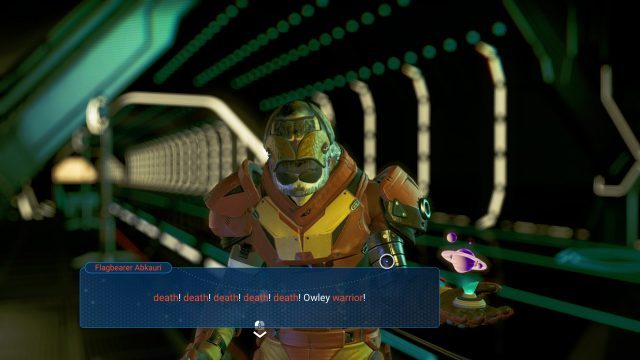
Even so, the droll dialogues offered by random NPCs in No Man’s Sky VR are almost always detached from your adventure, near-constantly failing to leave anything resembling a meaningful or emotional impact. But that flavor of tone deafness is to be expected when exploring a universe that flaunts itself on being ‘procedurally-generated’. Of course, the main ‘Atlas Rises’ campaign (which stars Artemis, one of the few handwritten NPCs you’ll spend some actual time getting familiar with) and the world-colliding multidimensional Space Anomaly do both offer characterization and context that is more dynamic and engaging than 99% of the other habitations you’ll experience across the galaxy. But it takes some time completing those aforementioned tutorial missions to get to them, and a new player may become bored and veer off before they reach either.
Comfort
No Man’s Sky VR does offer a few comfort options, though those are still quite limited in comparison to the broader scope and selection of comfort options available in many other modern VR games. You can choose between snap-turning or smooth-turning, teleportation or hand-tracked smooth locomotion, and you can switch comfort blinders on and off. Additionally, you don’t actually have to play with motion controllers if you prefer to play with a mouse and keyboard arrangement or a gamepad. I chose to play through 40 hours of the update with Oculus Touch controllers, all smooth locomotion, and with comfort blinders switched off. Since I don’t generally deal with any motion sickness in VR at all whatsoever, I enjoyed the experience just fine.
Unfortunately, I have thorough reason to believe that most people won’t be able to endure No Man’s Sky VR the same way that I have.
Simply put, the VR mode is, in its current rendition, far too buggy to have a consistent experience inside of. Understanding that there was a lot of game here for Hello Games to weave into virtual reality, I ran afoul of more crashes, frame-sinking performance issues (on my GTX 1070), and outright broken user interface components than I’ve ever seen while playing No Man’s Sky in desktop mode since I first began playing the game during its ‘Atlas Rises’ update in 2017.
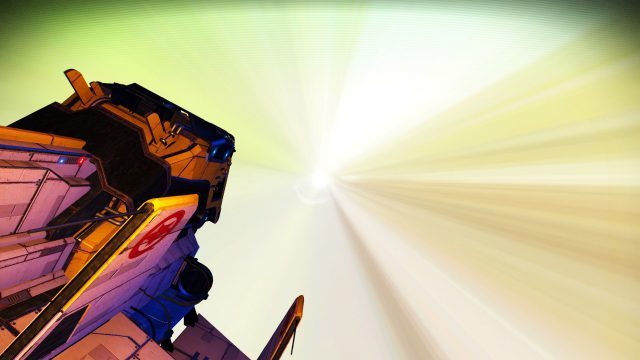
Shockingly, I found game breaking bugs present inside of common user interface interactions. Attempting to open my Multi-Tool and switch to the ‘Create’ function of the Terrain Manipulator inside of a space station or inside of my freighter locked me out of further gameplay interactions until I reverted to an autosave. Meanwhile, I found myself stuck in an interaction where trying to take a new base screenshot at a planetary ‘Base Computer’ turned my camera sideways and stopped my Touch controllers from inputting anything for a full 10 seconds. Yes, my entire view in VR was inexplicably turned sideways for several seconds.
To my dismay, there were serious bugs abound throughout the rest of the game as well. Wandering into the storage container units inside of my freighter dropped me underneath the capital ship’s cargo hold to my death. There’s no longer a way to upload all scanned systems, planets, flora, fauna, or minerals all at once, adding more time spent tediously floundering about inside of menu screens. Attempting to rename anything forced me to get out of my headset and use my actual physical keyboard in the real world to so much as back out of the interaction.
My list keeps going, but I’ve made my point. There are too many technical issues to list here and delineate in a timely manner, and that alone is the massive problem that I’m driving towards. It’s not even the individual bugs that I’m bothered by. It’s that much of the time there’s a feeling of needing to wrestle with the game in order to make it ‘work’. Furthermore, contending with so many bugs in No Man’s Sky VR means spending even more time staring at text in canvas menus, restarting saves, falling through the world, completely losing track of what my avatar is doing, losing track of the camera, and otherwise having an uncomfortable experience.
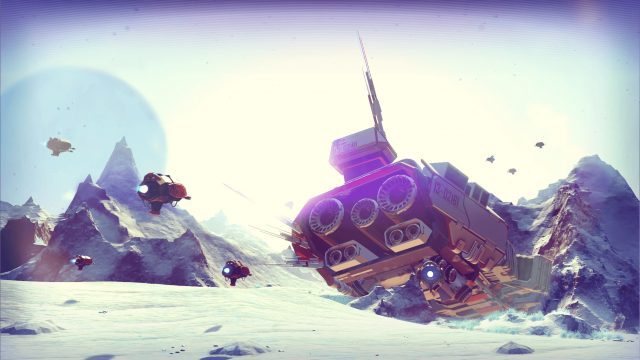
Can these issues be fixed through subsequent updates and patches? Totally. Do I expect them to be? Knowing Hello Games’ recent history, I have faith. Even outside of VR, I appreciate many of the ‘2.0’ bits of the Beyond update. But it’s safe to say that No Man’s Sky VR, while novel and exciting in many ways, is plagued with bugs, poor optimization, and seemingly obvious design oversights that create friction and, at worst, infrequently deplete the joy of playing in a headset.







